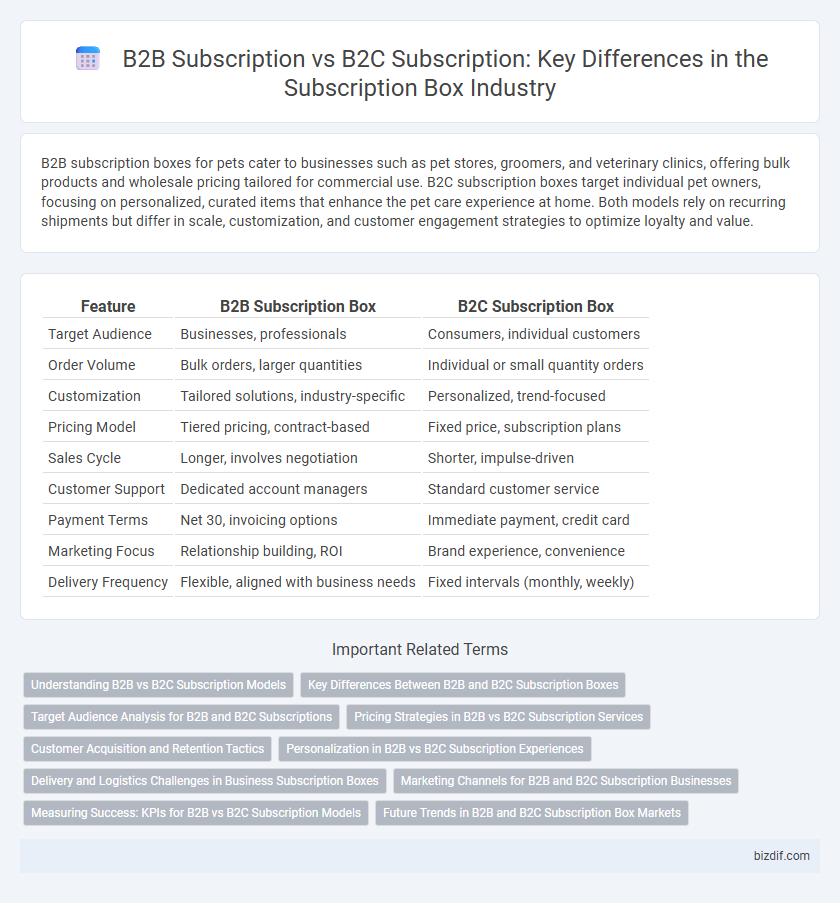B2B subscription boxes for pets cater to businesses such as pet stores, groomers, and veterinary clinics, offering bulk products and wholesale pricing tailored for commercial use. B2C subscription boxes target individual pet owners, focusing on personalized, curated items that enhance the pet care experience at home. Both models rely on recurring shipments but differ in scale, customization, and customer engagement strategies to optimize loyalty and value.
Table of Comparison
| Feature | B2B Subscription Box | B2C Subscription Box |
|---|---|---|
| Target Audience | Businesses, professionals | Consumers, individual customers |
| Order Volume | Bulk orders, larger quantities | Individual or small quantity orders |
| Customization | Tailored solutions, industry-specific | Personalized, trend-focused |
| Pricing Model | Tiered pricing, contract-based | Fixed price, subscription plans |
| Sales Cycle | Longer, involves negotiation | Shorter, impulse-driven |
| Customer Support | Dedicated account managers | Standard customer service |
| Payment Terms | Net 30, invoicing options | Immediate payment, credit card |
| Marketing Focus | Relationship building, ROI | Brand experience, convenience |
| Delivery Frequency | Flexible, aligned with business needs | Fixed intervals (monthly, weekly) |
Understanding B2B vs B2C Subscription Models
B2B subscription models focus on providing tailored products or services that meet the specific operational needs of businesses, often involving longer contract durations and bulk purchasing options. B2C subscriptions prioritize personalized experiences with flexible plans designed for individual consumers, emphasizing convenience and engagement. Understanding these differences is crucial for optimizing pricing strategies, customer retention, and service delivery in subscription commerce.
Key Differences Between B2B and B2C Subscription Boxes
B2B subscription boxes cater to businesses by offering bulk products or industry-specific solutions designed to enhance operational efficiency and employee engagement. In contrast, B2C subscription boxes focus on personalized consumer experiences with curated products tailored to individual preferences and lifestyles. Pricing models, contract terms, and delivery frequencies differ significantly, with B2B subscriptions often involving longer commitment periods and flexible order volumes compared to the typically shorter, fixed-duration plans found in B2C.
Target Audience Analysis for B2B and B2C Subscriptions
B2B subscription services primarily target businesses seeking scalable solutions, emphasizing factors like ROI, efficiency, and long-term partnerships, whereas B2C subscriptions focus on individual consumers driven by convenience, personalization, and brand experience. Analyzing target audiences in B2B involves detailed industry segmentation, decision-maker roles, and purchasing behavior, contrasted with B2C's demographic profiling, lifestyle preferences, and impulse buying tendencies. Understanding these distinct audience dynamics optimizes product offerings, marketing strategies, and customer retention for subscription box companies.
Pricing Strategies in B2B vs B2C Subscription Services
B2B subscription pricing strategies emphasize tiered plans based on usage volume or company size, often incorporating longer contract terms and negotiated rates to align with enterprise budgets and procurement cycles. B2C subscription models prioritize transparent, fixed pricing with frequent promotions to attract individual consumers, focusing on simplicity and lower entry costs to reduce friction. Understanding buyer behavior differences and value perception is essential to optimize pricing in B2B versus B2C subscription services.
Customer Acquisition and Retention Tactics
B2B subscription models leverage targeted lead generation, personalized onboarding, and account management to enhance customer acquisition and retention, focusing on building long-term relationships and high-value contracts. In contrast, B2C subscriptions rely on mass-market digital marketing, promotional offers, and user experience optimization to attract and retain a broad customer base. Data analytics and customer feedback drive retention strategies in both models, but B2B emphasizes customized solutions while B2C prioritizes convenience and engagement.
Personalization in B2B vs B2C Subscription Experiences
B2B subscription services emphasize advanced personalization through tailored product assortments, custom billing cycles, and integration with enterprise software, enhancing operational efficiency. In contrast, B2C subscriptions focus on individualized product selections and user experience, leveraging consumer data for personalized recommendations and flexible delivery options. The level of customization in B2B subscriptions typically involves deeper client collaboration and scalability to meet business-specific requirements, whereas B2C personalization centers on lifestyle preferences and consumption habits.
Delivery and Logistics Challenges in Business Subscription Boxes
B2B subscription boxes face complex delivery and logistics challenges due to bulk orders, variable delivery schedules, and customized packaging requirements tailored to different business clients. Unlike B2C subscriptions, which typically involve standardized shipments to individual consumers with predictable frequency, B2B deliveries demand scalable solutions that accommodate diverse inventory needs and fluctuating order volumes. Efficient route planning and real-time tracking systems are critical to manage timely deliveries, minimize shipping costs, and ensure customer satisfaction in the business subscription box sector.
Marketing Channels for B2B and B2C Subscription Businesses
B2B subscription businesses primarily utilize LinkedIn, industry-specific trade shows, and email marketing campaigns to target decision-makers and showcase product value. B2C subscription businesses focus on social media platforms like Instagram, Facebook, and influencer partnerships to engage consumers and build brand awareness. Both models leverage SEO and content marketing, but B2B channels emphasize educational and case study-driven content, while B2C channels prioritize lifestyle and experiential storytelling.
Measuring Success: KPIs for B2B vs B2C Subscription Models
KPIs for B2B subscription models emphasize customer lifetime value (CLV), churn rate, and average revenue per user (ARPU) due to longer sales cycles and contract-based agreements. In contrast, B2C subscription success relies heavily on monthly recurring revenue (MRR), customer acquisition cost (CAC), and engagement metrics like active subscribers and renewal rates. Understanding these distinct KPIs enables businesses to tailor strategies for customer retention, revenue growth, and profitability in each subscription model.
Future Trends in B2B and B2C Subscription Box Markets
The future trends in B2B subscription box markets emphasize customization, scalability, and integration with enterprise software for seamless supply chain management. In contrast, B2C subscription boxes are leaning towards hyper-personalization, eco-friendly packaging, and experiential unboxing to enhance customer engagement. Both sectors are increasingly adopting AI-driven analytics to optimize inventory and predict consumer preferences, driving growth and sustainability.
B2B subscription vs B2C subscription Infographic

 bizdif.com
bizdif.com